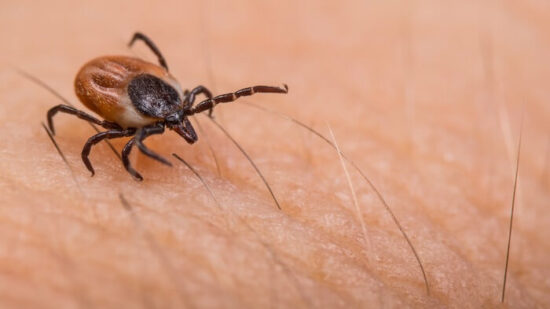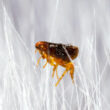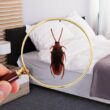Seeing tiny brown bugs in your house can be quite frustrating. Not only is it gross, but it’s hard to determine what they are!
This guide will cover the most common small brown bugs that will invade your home, and teach you how to get rid of them.
Table of contents
What Are The Tiny Brown Bugs In Your House?
The term “tiny brown bugs” is a common moniker that homeowners often use to describe unknown pests. While they all look similar, the nickname covers several unique species. Here are the most common.
1. Carpet Beetles
Carpet beetles are small brown bugs with oval-shaped bodies. Adult beetles are only about a quarter of an inch long and have a tough shell filled with color. Typically, you’ll see patches of black, gray, and brown.
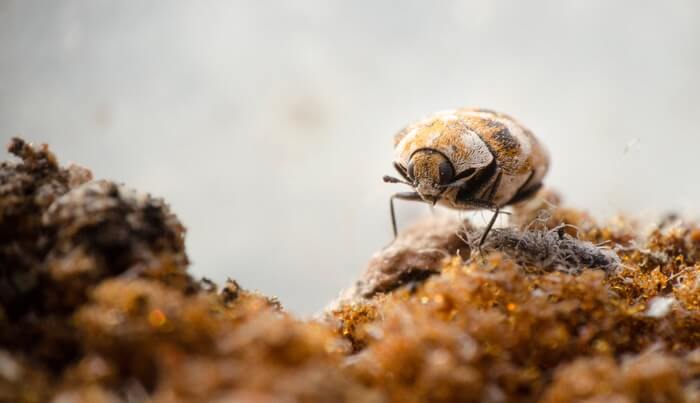
These little insects are slow-moving and often roll over to play dead when you attempt to touch them. The adults have a varied appetite. However, the larvae can do a lot of damage!
Carpet beetle larvae are known to eat through fabrics. They can chew through the carpets on your floors and wreak havoc on the clothes in your closet!
The baby beetles look very different from their adult counterparts. They are worm-like and covered in long spiky hairs. Both adults and larvae can be a nuisance, so they’re not a pest you should ignore.
Quick Tip: We have a guide on how to get rid of carpet beetles if you’re dealing with an infestation.
2. Silverfish
Here’s a creepy-looking insect you might have encountered before. Silverfish are ancient wingless insects with six legs and two long antennae. Their bodies have a distinct shape.
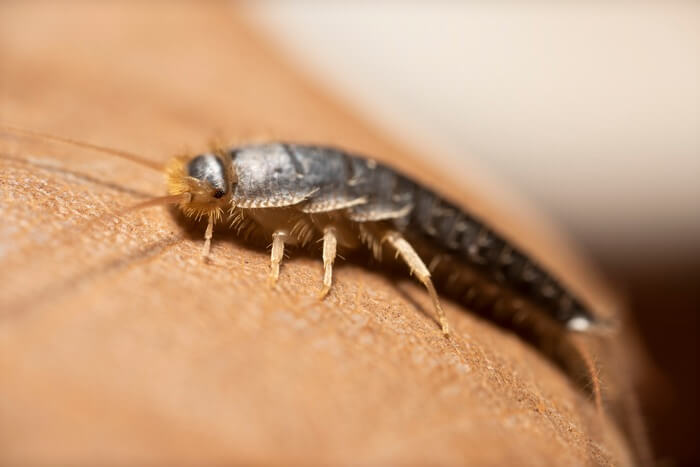
It’s wide at the head and tapers down to a point where three bristle-like appendages emerge. These little brown bugs move side-to-side as they crawl through your home, which is why many compare them to fish.
As their name would suggest, silverfish have a silvery sheen on the top of the body. It reflects light like fish scales, making the bugs easy to spot with a flashlight. The underside, however, is brown.
These tiny brown bugs can reach lengths of about three-quarters of an inch. While bigger than most tiny brown bugs, their unique bodies allow them to slip into tight spots with ease.
3. Weevils
Weevils are small beetles with pill-shaped bodies. They’re a bit more cylindrical than carpet beetles and can get twice as long. These beetles are also primarily dark brown or black.
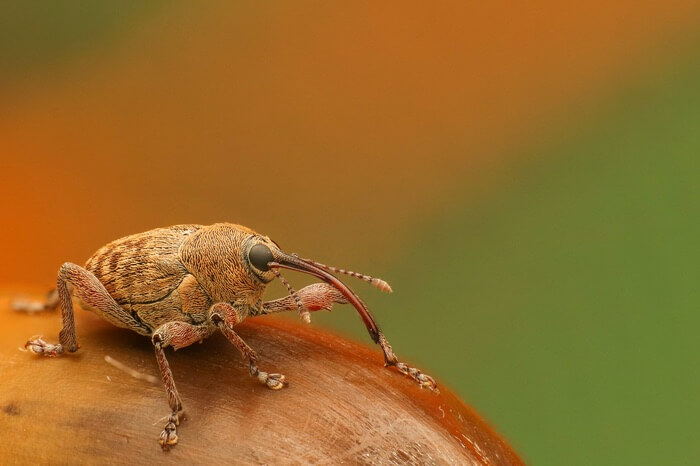
Another interesting physical quirk is the elongated head and signature snout. The snout’s length varies between weevil subspecies, but it’s almost always easy to spot. Many compare it to an elephant’s trunk!
These tiny brown bugs are relatively harmless as far as human health is concerned. However, they can do damage to crops, dry wood in your home, and food in your pantry.
4. Cockroaches
Most people know what roaches look like. Cockroaches are one of the most widespread household pests in the world! There’s a good chance that you have encountered adult roaches in the past. But what about the nymphs?
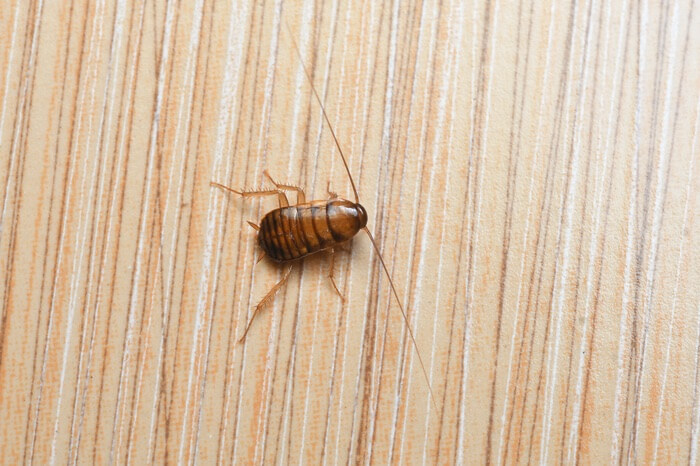
Nymphs are young cockroaches. Many homeowners see these small brown bugs and fail to realize that they’re freshly hatched roaches. They look pretty similar to adults upon closer inspection, but their small size and distinct color make them stand out.
Young roaches are grayish-brown. They continually molt and get darker with every passing shedding cycle. Like adults, nymphs have six legs and long antennae.
5. Ticks
Ticks are a rare sight in the home. You’re more likely to encounter them outside in the brush. However, they can invade homes if the conditions are right.
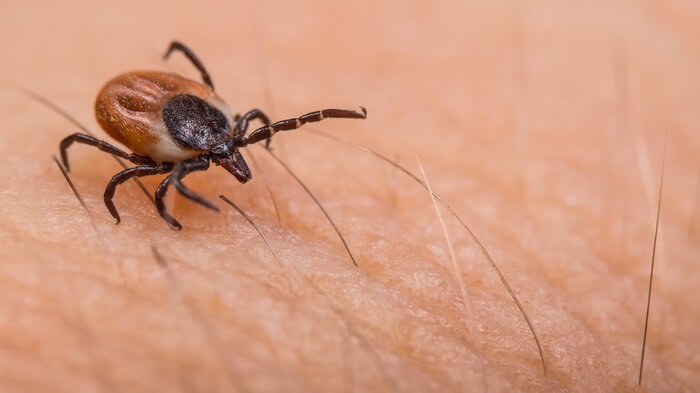
These tiny brown bugs measure about three millimeters long. If you get close enough to examine them, you’ll notice that they have eight little legs.
When they feed, ticks can multiply in size! Well-fed ticks balloon to look like smooth pebbles or rubber balls.
Should You Be Concerned?
Tiny brown bugs can invade virtually any room in your home, but does that mean you should worry about them?
All of these tiny brown bugs can cause trouble wherever they go. Carpet beetles can destroy clothing and upholstery. Meanwhile, silverfish will ruin your precious book collection as Weevils snack on the dry foods in your pantry!
They all have their unique quirks. Unfortunately, those behaviors are destructive and can cause real damage over time.
To make matters worse, tiny brown bugs in your house can quickly spread. These insects thrive indoors and will lay eggs to increase the bug population. That’s when things get out of hand, and damage becomes noticeable.
All that said, the worst part of having small brown bugs in your home is the potential for disease. Most bugs are relatively harmless beyond the physical damage they cause. However, some pose a significant threat to you and your family’s health.
The worst offenders are ticks and roaches.
Ticks are known carriers of many diseases. These bugs are parasitic by nature and feed on blood to survive. They can discreetly latch onto you, your family, or your pets.
Once they do, ticks can spread Lyme disease, tularemia, ehrlichiosis, and more.
Roaches don’t feed on blood, but they can carry disease-causing pathogens. They’re filthy insects that crawl through garbage, sewage waste, and more. Then, they move around your kitchen to find food!
Roaches are responsible for issues like dysentery, salmonella infection, and E. Coli.
Quick Tip: While most tiny brown bugs aren’t going to cause much health trouble, it’s not worth the risk. It’s essential to address infestations as soon as possible to keep your home happy and healthy.
What Attracts Them?
These critters are attracted to many things. Typically, food and shelter are their biggest motivators.
Tiny brown bugs often enter homes in search of the means for survival. They might investigate to get out of the elements. But the moment they find food, water, and shelter, they’re here to stay!
Most insect species are drawn to dark and warm spaces. Those environments are conducive to nesting and reproduction.
Silverfish and roaches also like to be near moisture. So, you might encounter them in kitchens, bathrooms, and anywhere there’s a leaking pipe. Humid rooms like the basement are enticing, too.
Weevils like to eat dry vegetable matter and grains. They’re particularly fond of dry goods in your food pantry and summertime crops. Many homeowners spot them feeding on flour or other grains!
The truth is that your home has a lot to offer these pesky small brown bugs. It’s a haven filled with all the things they need to survive. There’s no getting around that.
Your home is bound to attract insects. However, there are things you can do to eliminate them and prevent them from coming back.
How To Get Rid Of Tiny Brown Bugs
Getting rid of tiny brown bugs requires vigilance and a bit of knowledge. The first thing you should do is identify your insect opponent. Knowing what bug you’re dealing with can help you adjust your extermination efforts for the most impact possible.
Here are some core extermination methods you can use to tackle most small brown bugs.
Remove Infested Items
The first thing you should do is remove any infested item. Not all bug species are going to stick to one item. But those that do are pretty easy to remove.
Say, for example, that you see a box of whole-grain oats that weevils chewed their way through. Or, maybe there’s a cardboard box full of books that silverfish have decided to snack on.
Whatever it is, get rid of the item ASAP!
Place the infested goods into a plastic bag and toss them in the trash. That might not get rid of the entire nest, but it will take care of a good chunk of the population. Plus, it eliminates the item that attracted them and any existing pheromone trails.
Clean Problem Areas
Next, do a bit of cleaning.
Many small brown bugs are naturally attracted to clutter. Clutter provides plenty of hiding places. Furthermore, those junk items can serve as a valuable food source for some insects.
Cleaning will remove the protection insects desperately need to move around undetected. It’s a great way to drive bugs out while making those that stick around more visible for manual removal.
Set Up Traps
Here’s where learning more about the insect you’re dealing with comes in handy.
Bait traps are a fantastic tool to have in your extermination arsenal. Traps don’t just get rid of the tiny brown bugs that are out and about. Some can also eliminate the larger nest that’s hiding behind your walls.
Choose traps that appeal to the insect in question. Many targeted commercial products are available if you want to keep things simple. For example, you can get poison traps for roaches, silverfish, and more.
Those products utilize bait foods that the insects naturally gravitate to. The bait also happens to be laced with slow-acting poison like borax or boric acid. The bugs that discover the bait will not experience ill effects immediately.
As a result, they bring it to the colony and spread the poison around to other insects. By the time the first bugs start dying, the rest are already doomed!
Quick Tip: Commercial products are easy to set up and use. However, you can also create your own with borax and appropriate bait foods.
If you’re unsure about what insect is causing trouble, try using sticky traps. Sticky traps won’t tackle the entire colony, but they will stop bugs from spreading. Glue-filled surfaces trap the insects until they starve.
Place a few in areas where you’ve seen the tiny brown bugs. It should take long before you start seeing dead insects!
Apply Insecticides & Repellents
You can’t go wrong with insecticides and repellents.
Insecticides are readily available and have high efficacy rates. They utilize chemical ingredients, so make sure to read all safety information and exercise caution during application.
The good news is that insecticides can kill most small brown bugs on contact by disrupting the nervous system. The bad news is that you have to see the bugs to attack them with insecticidal spray.
Fortunately, repellents are an option as well. Repellent sprays act like an invisible barrier around your home. They drive existing bugs out of your home while preventing others from getting in.
Use the spray liberally and apply it to all entry points. You can also use it in rooms where you have encountered tiny brown bugs.
Quick Tip: If you’re unsure about the application, get help from an exterminator! A professional exterminator can choose the right products for your particular needs.
Ways To Prevent Them From Returning
Eradicating the small brown bugs inside your house is only half the battle. There’s always a chance that they’ll return. To prevent that from happening, use these tips to make your home as bug-proof as possible.
Clean Regularly
As we mentioned earlier, an unkempt home is like setting a fast-track for bug infestation. Don’t let your home get too untidy. Adopt a strict cleaning schedule and stick to it!
Dust shelves, vacuum the floors, and wipe down surfaces. Cleaning isn’t just for your health. It’ll make your home unappealing while also taking care of any bugs that might have slipped through the cracks.
When you vacuum, there’s a good chance that you’ll pick up stray bugs and eggs. As you wipe down surfaces, you’re getting rid of scent trails and smells that might draw the little bugs in.
Take time out of your week to keep your home spotless.
Maintain Your Yard
It’s a good idea to provide the same care to your yard as you do your home.
Those tiny brown bugs start as outdoor pests before they migrate into your home. One of the best things you can do is keep your yard well-maintained so that they don’t enter your property at all.
Mow the grass and trim back any unruly bushes. Pay special attention to any areas that have a lot of vegetation. Those spots are perfect for ticks and roaches.
To go the extra mile, keep the perimeter of your home clean and plant-free. Consider applying a thick layer of mulch around a foot out from the walls. You can also use some outdoor pest repellents for good measure.
Seal Potential Access Points
Those small brown bugs have to get in somehow! Usually, it’s through access points you never realized were present.
Inspect your home’s perimeter and look for tiny cracks or voids. There’s a good chance that you have some around the foundation, surrounding doors, around windows, and more.
Seal those voids up! You can use caulk, stucco, or anything else that’s impenetrable. Closing the cracks will instantly make it harder for bugs to get through.
Use Plastic Containers
Little brown bugs can easily get into your storage and eat the things you cherish most. From clothes to pantry staples, these bugs will eat it all.
You don’t have to forgo keeping those items in your home. However, it’s a good idea to keep them in bug-proof containers.
Instead of keeping clothes, books, and dry goods in cardboard boxes, consider upgrading to better storage containers.
Use airtight plastic containers. Bugs can’t chew through the plastic, so your items stay safe from hungry pests. More importantly, it eliminates a food source and makes your home a little less appealing.
Conclusion
Tiny brown bugs in your house don’t need to be a nuisance. In fact, once you know what to do, getting rid of them is a piece of cake!
We hope you found this guide helpful. If you have any questions for us feel free to send us a message through our contact page.
